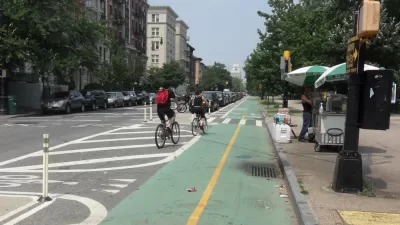While Angie Schmitt doesn't ask this question in her article on the movement behind these lanes, she writes that cities without them "are being left behind". They're popular because they effectively address the #1 reason for not riding: safety

You may know them as 'green lanes' or 'cycle tracks' - they are "a special class of premium bike infrastructure" in which the bike lane is separated from car traffic by several means. It could be a row of parked cars or plastic bollards; sometimes it's just striped paint. "As planners look for more permanent options, more formidable obstacles like landscaping planters or curbs are being used," Schmitt writes.
In this comprehensive look behind the movement toward protected bike lanes, Schmitt begins with the controversial Prospect Park West bike lane in Brooklyn, N.Y. She credits the opponents, "dismissed as irrational and parochial by cycling advocates", for knowing "how quietly revolutionary that little green stripe of pavement would be". But real credit goes to the lanes themselves for reducing "crashes and injuries of all kinds... by 63 percent".
Playing an instrumental role in the advancement of protected bike lanes is the "Green Lane Project, a nonprofit project of bike advocacy group Bikes Belong working with six cities...to install protected bike infrastructure." According to director Martha Roskowski:
Last year alone, the number of protected bike lanes in the United States nearly doubled from 62 to 102. This year, the number is expected to double again. Protected bike lanes are now in place in 32 cities across the United States.
Success is not measured by the increase in lane miles of protected lanes, but in getting more folks to take to bike pedals rather than gas pedals.
For decades, in the United States, the cycling rate has held stubbornly around 1 percent – despite the fact that almost 50 percent of trips Americans make by any mode are three miles or less. “The number one reason people don't ride is that they don't feel safe,” said Roskowski. “When we put in the protected lanes, people feel safe.”
And numbers prove Roskowski's point. As reported here on October 23, 2012, a recent study published in the American Journal of Public Health indicated that "protected bike lanes – with actual barriers separating cyclists from traffic – really make a difference. The risk of injury drops for riders there by 90 percent."
FULL STORY: The Rise of The North American Protected Bike Lane

Maui's Vacation Rental Debate Turns Ugly
Verbal attacks, misinformation campaigns and fistfights plague a high-stakes debate to convert thousands of vacation rentals into long-term housing.

Planetizen Federal Action Tracker
A weekly monitor of how Trump’s orders and actions are impacting planners and planning in America.

In Urban Planning, AI Prompting Could be the New Design Thinking
Creativity has long been key to great urban design. What if we see AI as our new creative partner?

Massachusetts Budget Helps Close MBTA Budget Gap
The budget signed by Gov. Maura Healey includes $470 million in MBTA funding for the next fiscal year.

Milwaukee Launches Vision Zero Plan
Seven years after the city signed its Complete Streets Policy, the city is doubling down on its efforts to eliminate traffic deaths.

Portland Raises Parking Fees to Pay for Street Maintenance
The city is struggling to bridge a massive budget gap at the Bureau of Transportation, which largely depleted its reserves during the Civd-19 pandemic.
Urban Design for Planners 1: Software Tools
This six-course series explores essential urban design concepts using open source software and equips planners with the tools they need to participate fully in the urban design process.
Planning for Universal Design
Learn the tools for implementing Universal Design in planning regulations.
Gallatin County Department of Planning & Community Development
Heyer Gruel & Associates PA
JM Goldson LLC
City of Camden Redevelopment Agency
City of Astoria
Transportation Research & Education Center (TREC) at Portland State University
Jefferson Parish Government
Camden Redevelopment Agency
City of Claremont


























